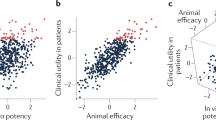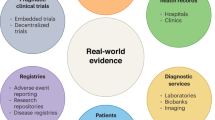Abstract
The costs associated with the development of new drugs have increased dramatically in recent years, and fewer truly innovative drugs are making their way to the market. The reversal of this trend has therefore become an urgent priority for the pharmaceutical industry. What are the factors that contribute to these costs, and to what extent can they be effectively controlled? Does the solution lie in new technologies? How is the industry dealing with these problems? And what are the ethical implications of these trends?
This is a preview of subscription content, access via your institution
Access options
Subscribe to this journal
Receive 12 print issues and online access
$209.00 per year
only $17.42 per issue
Buy this article
- Purchase on Springer Link
- Instant access to full article PDF
Prices may be subject to local taxes which are calculated during checkout



Similar content being viewed by others
References
Geiling, E. M. K. & Cannon, P. R. Pathologic effects of elixir of sulphanilamide (diethylene glycol) poisoning. J. Am. Med. Assoc. 111, 919–926 (1938).
Temple, R. in Principles of Pharmacology (ed. Munson, P. L.) 1643–1663 (Chapman A. Hall, New York, 1995).
Federal Food, Drug and Cosmetic Act. As amended. Code of Federal Regulations, Title 21, Publication n. 667340 (US Government Printing Office, Washington DC, 1963).
Tishler, M. The role of industry in national science policy. The people's welfare: health and medicine. Persp. Biol. Med. 13, 528–535 (1970).
Berkowitz, B. A. & Katzung, B. G. Basic and Clinical Pharmacology 9th edn (ed. Katzung, B. G.) 67–74 (Lange Medical/McGraw–Hill, New York, 2004).
Pritchard, J. F. et al. Making better drugs: decision gates in non-clinical drug development. Nature Rev. Drug Discov. 2, 542–553 (2003)
DiMasi, J. A., Hansen, R. W., Grabowski, H. G. & Lasagna, L. Research and development costs for new drugs by therapeutic category: a study of the U. S. pharmaceutical industry. PharmacoEconomics 7, 152–169 (1995).
DiMasi, J. A. Success rates for new drugs entering clinical testing in the United States. Clin. Pharmacol. Ther. 58, 1–14 (1995).
Monzo, A. & Mehta, D. Are single-dose toxicology studies in animals adequate to support single doses of a new drug in humans? Clin. Pharmacol. Ther. 59, 258–264 (1996).
Polastro, E. T. Managing primary development for competitive edge. Scrip Magazine, 33–34 (November 1995).
Editorial. 18 new blockbusters by 2008, with $ 24 billion sales forecast. PharmacoMarket Letter 29, 24–25 (July 1, 2002).
DiMasi, J. A. Risks in new drug development: approval success rates for investigational drugs. Clin. Pharmacol. 69, 297–307 (2001).
DiMasi, J. A., Hansen, R. W. & Grabowski, H. G. The price of innovation: new estimates of drug development costs. J. Health Econ. 22, 151–185 (2003).
Styliani, E. R. & D costs are staggering. Pharmacobusiness 48 (January/February 2002).
Greaves, P., Williams, A. & Eve, M. First dose of potential new medicines to humans: how animals help. Nature Rev. Drug Discov. 3, 226–236 (2004).
Claude, J. R. Les études de sécurité des produits en dévelopment dans l'industrie pharmaceutique. Ann. Pharm. Fr. 59, 324–330 (2001).
Regan, T. Defending Animal Rights (University of Illinois Press, 2001).
Roberts, I., Kwan, I., Evans, P. & Haig, S. Does animal experimentation inform human healthcare? Observations from a systematic review of international animal experiments on fluid resuscitation. BMJ 324, 474–476 (2002).
Paton, W. Man and mouse — animals in medical research 44 (Oxford Med. Press, 1984).
Ellen Frankel, P. Jeffrey, P. Why Animal Experimentation Matters: the Use of Animals in Medical Research (Transactions Publishers, 2001).
Shaw, W. H. Cost and benefits of inflicting pain. Nature 414, 396–397 (2001).
Wickelgren, I. Animal studies raise hopes for spinal cord repair. Science 297, 178–181 (2002).
Nies, A. S. in Goodman and Gilman's The Pharmacological Basis of Therapeutics 10th edn (eds. Hardman, J. G. & Limbird, L. E) 45–66 (McGraw Hill, New York, 2001).
Reichert, J. M. Trends in development and approval for the new therapeutics in the United States. Nature Rev. Drug Discov. 2, 695–702 (2003).
DiMasi, J. New drug development in the United States from 1963 to 1999. Clin. Pharmacol. Ther. 69, 286–296 (2001).
Mitka, M. Accelerated approval scrutinized. Confirmatory Phase 4 studies or new drug languish. J. Am. Med. Assoc. 289, 3227–3229 (2003).
Goldstein, A., Aronow, L. & Kalman, S. M. Principles of Drug Action. The Basis of Pharmacology 2nd edn 815 (J. Wiley a. Sons, Chichester, 1974).
Lewis, I. A. Post marketing surveillance. how many patients? Trends Pharmacol. Sci. 2, 93–94 (1971).
Freeman, J. in Drug Safety: A Shared Responsibility, International Drug Surveillance Department Glaxo Group Res. Ltd. 13–26 (Churchill Livingstone, Edinburgh 1991).
Generali, J. A. Drug withdrawals in the US: 1980 to 2001. Drug facts and comparison news 43–45 (Facts and Comparisons, a Wolters Kluwer Company, St. Louis, 2001).
McQuaid, K. R. in Basic and Clinical Pharmacology (ed. Katzung, B. G.) 1049 (Lange Medical/McGraw Hill, New York, 2004).
Farmer, J. A. Learning from the cerivastatin experience. Lancet 358, 1383–1384 (2001).
Katzung, B. G. in Basic and Clinical Pharmacology 9th edn (ed. Katzung, B. G.) 267 (Lange Medical/McGraw Hill, New York, 2004).
Elliott, W. I. Nefazodone under attack once again. Pharmacol. Watch, May 2003, 2 (Thomson American Health Consultants, Atlanta 2003).
Edwards, I. R. Withdrawing drugs: nefazodone, the start of the latest saga. Lancet 361, 1240 (2003).
Editorial. R. & D. revolution remains just around the corner. Scrip Magazine February, 72–73 (2002).
Watters, J. W. & McLeod, H. L. Using genome-wide mapping in the mouse to identify genes that influence drug response. Trends Pharmacol. Sci. 24, 55–58 (2003).
Evans, W. E. & McLeod, H. L. Pharmacogenomics — drug disposition, drug target, and side effects. N. Engl. J. Med. 348, 538–549 (2003).
Weinshilboum, R. Inheritance and drug response. N. Engl. J. Med. 348, 529–537 (2003).
Weinstein, J. N. Pharmacogenomics — teaching old drugs new tricks. N. Engl. J. Med. 9, 1408–1409 (2000).
Roses, A. D. Genome-based pharmacogenetics and the pharmaceutical industry. Nature Rev. Drug Discov. 1, 541–549 (2002).
2002 Workshop on Pharmacogenetics/Pharmacogenomics in drug development and regulatory decision-making. Chairpersons: L. Lesko, R. A Salerno. www.fda.gov/CDER/Calendar/MEETING/PHARMA52002/default.htm
Phillips, K. A., Veenstra, D. L., Oren, E., Lee, J. K. & Sadee, W. Potential role of pharmacogenomics in reducing adverse drug reactions. J. Am. Med. Assoc. 286, 2270–2279 (2001).
Holmes, E. Methodological approach in metabonomics. Tox. Lett. 144 (Suppl. 1), S4 (2003).
Thompson, D. C. Methodological approaches in proteomics. Tox. Lett. 144 (Suppl. 1), S4 (2003).
Editorial. Genomics may increase costs of NCE development says Lehman Bros. PharmaMarkeletter 28, 24–25, February 2001.
Lord, P. G. Progress in applying genomics in drug development. Tox. Lett. 144 (Suppl. 1), S4 (2003).
Author information
Authors and Affiliations
Ethics declarations
Competing interests
The author declares no competing financial interests.
Related links
Rights and permissions
About this article
Cite this article
Preziosi, P. Science, pharmacoeconomics and ethics in drug R&D: a sustainable future scenario?. Nat Rev Drug Discov 3, 521–526 (2004). https://doi.org/10.1038/nrd1418
Issue Date:
DOI: https://doi.org/10.1038/nrd1418
This article is cited by
-
Dynamic all-optical drug screening on cardiac voltage-gated ion channels
Scientific Reports (2018)
-
OptoDyCE as an automated system for high-throughput all-optical dynamic cardiac electrophysiology
Nature Communications (2016)
-
High-throughput electrophysiology: an emerging paradigm for ion-channel screening and physiology
Nature Reviews Drug Discovery (2008)
-
Reporter mice and drug discovery and development
Nature Reviews Drug Discovery (2005)



